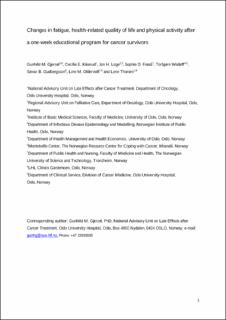| dc.contributor.author | Gjerset, Gunhild Maria | |
| dc.contributor.author | Kiserud, Cecilie E. | |
| dc.contributor.author | Loge, Jon Håvard | |
| dc.contributor.author | Fosså, Sophie Dorothea | |
| dc.contributor.author | Wisløff, Torbjørn | |
| dc.contributor.author | Gudbergsson, Sævar Berg | |
| dc.contributor.author | Oldervoll, Line Merethe | |
| dc.contributor.author | Thorsen, Lene | |
| dc.date.accessioned | 2020-04-14T07:25:56Z | |
| dc.date.available | 2020-04-14T07:25:56Z | |
| dc.date.created | 2019-06-04T11:06:41Z | |
| dc.date.issued | 2019 | |
| dc.identifier.citation | Acta Oncologica. 2019, 58 (5), 682-689. | en_US |
| dc.identifier.issn | 0284-186X | |
| dc.identifier.uri | https://hdl.handle.net/11250/2650866 | |
| dc.description.abstract | Background: Rehabilitation aims to improve function, but the effects of different programs are not clear. The aims of the present study were to: (1) compare the level of fatigue and health-related quality of life (HRQOL) of cancer survivors admitted to a one-week inpatient educational program (IEP) to the general population (NORMS), (2) examine changes in fatigue, HRQOL and physical activity after the IEP and (3) examine the proportions of survivors for female and male separately with clinically relevant improvement (>10% of maximum scale).
Methods: Cancer survivors ≥18 years, diagnosed with breast-, prostate- or gastrointestinal cancer within the last 10 years, about to attend a one-week IEP were invited to an observational study with a pre-post design. The IEP included lectures, group discussions and physical activity. The participants completed a questionnaire on the arrival day (T0) and three months after the stay (T1). Fatigue was assessed by the Fatigue Questionnaire and HRQOL by Short Form-36.
Results: Compared to NORMS, both female and male participants had significantly higher mean levels of fatigue and poorer HRQOL at T0 and T1. From T0 to T1, among all participants physical fatigue was reduced from 12.6 (SD 3.9) to 11.8 (SD 3.8; p < .001), mental fatigue from 6.3 (SD 2.2) to 6.0 (SD 2.2; p = .044) and total fatigue from 19.0 (SD 5.3) to 17.8 (SD 5.4; p = .001). Among female participants, 30% experienced clinically relevant improvement in physical fatigue, 28% in total fatigue and 36% in general health. Of male participants, 31% displayed a clinically relevant improvement in role limitations physical.
Conclusion: Participants in the IEP reduced their levels of fatigue and improved aspects of HRQOL, more often observed among female participants than among males. Because of the lack of a control group it is not possible to conclude whether the changes were due to the IEP. | en_US |
| dc.language.iso | eng | en_US |
| dc.publisher | Taylor & Francis | en_US |
| dc.title | Changes in fatigue, health-related quality of life and physical activity after a one-week educational program for cancer survivors | en_US |
| dc.type | Peer reviewed | en_US |
| dc.type | Journal article | en_US |
| dc.description.version | acceptedVersion | en_US |
| dc.source.pagenumber | 682-689 | en_US |
| dc.source.volume | 58 | en_US |
| dc.source.journal | Acta Oncologica | en_US |
| dc.source.issue | 5 | en_US |
| dc.identifier.doi | 10.1080/0284186X.2018.1562210 | |
| dc.identifier.cristin | 1702554 | |
| dc.description.localcode | This is an [Accepted Manuscript] of an article published by Taylor & Francis, available at https://doi.org/10.1080/0284186X.2018.1562210 | en_US |
| cristin.unitcode | 194,65,20,0 | |
| cristin.unitname | Institutt for samfunnsmedisin og sykepleie | |
| cristin.ispublished | true | |
| cristin.fulltext | preprint | |
| cristin.qualitycode | 1 | |
